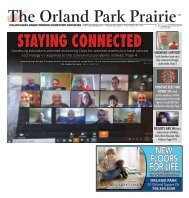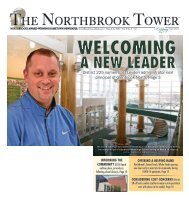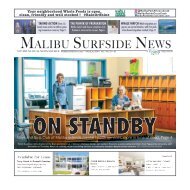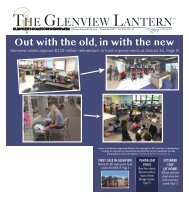Create successful ePaper yourself
Turn your PDF publications into a flip-book with our unique Google optimized e-Paper software.
To find the heart of a community, one must<br />
turn to its past.<br />
For centuries, the land upon which Mokena now stands was<br />
home to different bands of Native Americans, the Potawatomis<br />
and their wigwams having been documented near Hickory Creek<br />
in the early 19th century. The young family of John McGovney<br />
were the first brave pioneers to settle the neighborhood, the<br />
Ohioans having arrived in 1831. Their tough frontier life was soon<br />
interrupted by the Black Hawk War, which sent them temporarily<br />
fleeing to more densely settled parts. They returned in 1834 and<br />
soon found new neighbors in John Atkins of Vermont and Allen<br />
Denny of New York. With others, they broke the untamed prairie<br />
where Mokena would later prosper.<br />
With the construction of the Chicago, Rock<br />
Island and Pacific Railroad in 1852, Allen Denny<br />
subdivided several lots near Wolf Road along<br />
today’s Front and First Streets.<br />
To his small development he assigned the name Mokena,<br />
marking the first recorded usage of the name. Many theories<br />
have abounded as to what the rustic word could mean,<br />
although modern research indicates that it signifies “turtle” in<br />
the Algonquin tongue. Not long thereafter, John McGovney<br />
completed an addition to Denny’s subdivision. These first steps,<br />
along with the establishment of a post office in the winter of<br />
1853, heralded the birth of our community. A stop along the<br />
railroad brought commerce; early business houses were an inn,<br />
a general store and a blacksmith shop. A schoolhouse was built in<br />
1855. At this early time, the majority of Mokena residents were<br />
of Germanic heritage.<br />
The carnage of the Civil War years awakened the<br />
young settlement’s spirituality.<br />
The German United Evangelical St. John’s Church was founded<br />
in 1862, followed by St. Mary’s German Catholic Church in 1864.<br />
Shortly after the war’s end, the Methodists constructed a church<br />
building in 1867. All three of these congregations have withstood<br />
the test of time, remaining an integral part of Mokena to this day.<br />
By 1878, around 600 people lived in the little burg, which was<br />
known throughout Will County as a shipping and trading center<br />
for grain. In June 1880 Mokena was successfully incorporated by<br />
referendum vote. Having been elected by the town’s male voters,<br />
the newly formed village board selected Ozias McGovney as<br />
their first mayor. One of the board’s first acts was licensing of the<br />
numerous saloons that abounded in the village.<br />
Mokena enjoyed heady days until a sharp decline<br />
struck at the end of the 19th century.<br />
Economic hardship due to the nationwide Panic of 1893, bad<br />
roads, and increased rail traffic to other nearby locales lead many<br />
residents and business to relocate. During the lowest ebb, the<br />
village counted a meager 281 inhabitants in 1900. The village<br />
experienced a slow but gradual comeback, marked first by the<br />
establishment of the Bowman Dairy’s milk bottling plant in 1907,<br />
and the opening of the Mokena State Bank in 1909. Gleaming<br />
electricity was first introduced to the town in 1913.<br />
history and<br />
heritage<br />
The concreting of Wolf Road began in 1930 and<br />
finally ended in 1936, the long gap being due to a<br />
particularly intense property dispute.<br />
The champion of this much-needed civic improvement was<br />
William Semmler, a tireless Mokena booster as well as the editor<br />
of The News-Bulletin, the community’s trustworthy newspaper.<br />
Founded by Semmler in 1919, the publication existed until 1969.<br />
The small town weathered the Great Depression quite well,<br />
and overcame the desperate years of World War II through the<br />
bravery of at least 125 local heroes, who were bolstered by the<br />
sturdiness of Mokenians at home.<br />
A rich agricultural tradition characterized<br />
the life of Mokena from it’s earliest days until<br />
relatively recently.<br />
In the years after World War II, the village changed from a rural<br />
farm town to a suburb of Chicago. The subdivisions of Mineral<br />
Springs and Sunny Acres attracted newcomers in the first years<br />
after the war, while the opening of Interstate 80 in 1968 just<br />
north of Mokena simplified transportation to points farther<br />
afield. At the end of the 20th century, the community experienced<br />
a boom. In 1990, slightly more than 6,000 people lived within the<br />
incorporated limits, and in 2000, the population had more than<br />
doubled, counting approximately 14,000 residents. The 1990s<br />
also registered 23 housing developments, a number previously<br />
unseen in local history. The reputation for great living and<br />
friendly locals is still carried on in the 21st century. Mokena is not<br />
simply another village, but also a home.<br />
By Matthew T. Galik | Matthew T. Galik is a Mokena resident and<br />
author of the 2011 book Images of America – Mokena, Published by Arcadia<br />
Publishing. Copies of this book are available for purchase at the Mokena<br />
Chamber of Commerce Office, 19150 S. Wolf Road, Suite C, Mokena, IL<br />
60448.<br />
mokena.com | Mokena Chamber of Commerce 11


















